10 Ways to Ruin an Old Building
Jonathan Taylor
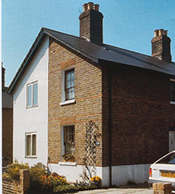 |
1 Employ consultants and contractors who do not specialise in historic
building work Despite extensive redevelopment which damaged so many historic centres, particularly in the 1960s and ‘70s, almost all our towns and cities retain pre-20th century historic cores, and around one in five buildings today pre-dates 1914. In those urban centres where historic integrity is strong, the character is maintained not only by planning control but also by peer-pressure and increasing recognition that insensitive alterations will damage the financial value of the owners’ properties. However far more old buildings have been hidden under a veil of alterations, and in many cases poor alterations and a lack of maintenance threatens their survival. Today major redevelopment in historic centres is rare, and the greatest threat comes from the small, insidious ‘improvements’ often made by well intentioned but misinformed owners, their contractors and consultants, as well as from a lack of regular maintenance. Traditionally constructed buildings do not perform in the same way as modern ones and need to be treated differently, at every stage of their conservation and repair. Modern materials and construction techniques are often incompatible with traditional ones, and repairs which are suitable for modern buildings can lead to the deterioration of historic building fabric. Relatively few contractors and consultants have the expertise required to deal with the special problems of historic buildings, and even relatively harmless techniques can damage historic materials in the wrong hands. |
A few simple alterations have made one half of this attractive Victorian
house look modern, and the loss of the garden and its front wall have
added to the erosion of a conservation area (Kit Wedd) |
|
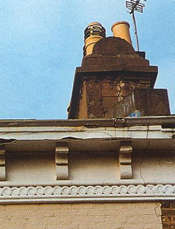 |
2 Do not carry out any essential maintenance work
|
Visible
signs of decay caused by poor maintenance |
|
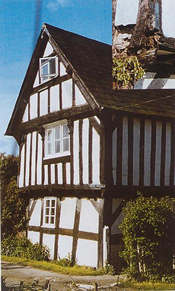 |
3 Use cement in place of lime for mortars
|
A
timber framed house with panels re-rendered using a hard cement; the
panels allow rain to penetrate the walls at their junction with the
exposed timbers but the hard render restricts its evaporation, causing
extensive decay (Robert Demaus) |
|
|
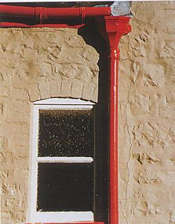 |
4 Paint or coat surfaces which were originally left natural
|
Evaporation
of moisture from a wall is concentrated by an impermeable coating
at cracks, leading to localised stone decay due to salt crystallisation.
The use of colour to emphasise the drain pipe is also questionable |
|
|
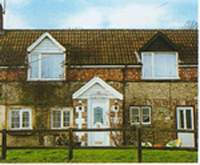 |
5 Extend or alter the accommodation in a manner which conflicts with its style
|
This
early 18th century cottage with dressed stone windows has been altered
and extended many times this century, most recently with the top-heavy
dormer windows and the porch (see next illustration) |
|
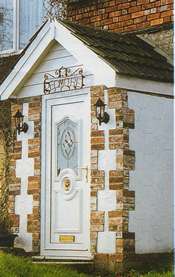 |
6 Introduce mix-and-match ‘period style’ detail
|
These
details have been chosen to look 'quaint’, but would be more in keeping
with the character of a modern housing estate than this 18th century
cottage |
|
|
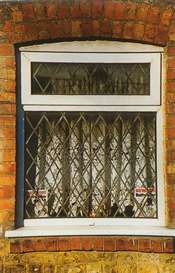 |
7 Replace original components unnecessarily
|
New
plastic windows in particular detract from the character of old buildings |
|
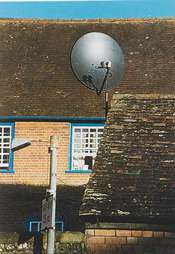 |
8 Position modern services and equipment intrusively
|
Satellite
dishes need to point in a particular direction, but they do not need
to be on the front of a house, nor do they need to be coloured black |
|
|
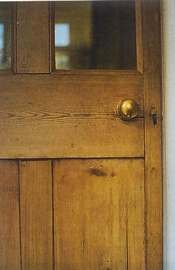 |
9 Use cleaning methods which damage original surfaces
|
Dipping
in a bath of caustic soda is by far the cheapest way to paint-strip
doors, but also the most damaging to the timber and the joints in
particular |
|
|
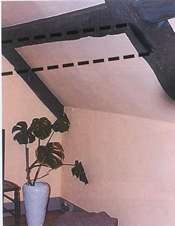 |
10 Overload an existing structure
|
The
tie beams literally tie the two sides of the roof together. Their
removal to make an attic usable can lead to the collapse of the roof
(the location of the tie beams removed in the past is indicated by
the dotted lines) |
|
|
| THE CAREFUL ALTERNATIVE |
| CONSERVATION |
| Taken out of context, this long list of don'ts would no doubt cement many people’s view that conservation is all about freezing buildings and places in a perpetual time warp at the expense of any function. However, conservation encompasses a broad range of measures and approaches to historic buildings, and at its best conservation is an extremely creative process. |
| Within the field of building conservation, the term 'conservation' may be defined as the process of protecting a building and its surroundings from any change that might involve a loss of historic fabric, historic importance or character. This process is made more complex by the fact that most buildings have an active function, and the need to accommodate the function is a recognised facet of building conservation. |
| A distinction needs to be made between conservation, preservation and restoration, which are often erroneously used to mean the same thing. In the field of building conservation the term 'preservation' is generally used to distinguish a particular type of conservation work sometimes referred to as ‘conservation as found’, in which the fabric is preserved in the state in which it was at the start of the project. Conservation, on the other hand, may involve an element of alteration, for example; to maintain the functional use of the building, or to prevent its further decay. |
| Restoration is another term used erroneously to mean conservation. Here the issues are more complex, since some restoration work may involve stripping away historic alterations to reveal earlier fabric, and in most restoration work new material is introduced to match missing components. In this respect the aim of restoration is clearly different from that of conservation, and some restoration work may actually damage the historic character of the building. Nevertheless, most conservation work involves some element of restoration, particularly where essential repairs are carried out to match the original form of a decayed component, where the aim is primarily to conserve fabric. |
| Although conservation does not mean freezing a building in its present state for perpetuity, it does mean that all alterations must be carefully justified beforehand, taking into account not only the affect of the works in the short term but also their consequences for the building, its character, historic interest and its functionality in the future. Historic architecture can often be adapted to meet modern requirements without loosing any historic fabric or with alterations which are designed to be 'reversible'. Where buildings which are listed or in conservation areas are concerned, the degree of alteration permitted by local authorities will vary according to the importance of the building and the components affected and how essential the alteration is to the function of the building. |
| Developing a caring approach to old buildings is essential to the whole community. Historic architecture affects us all, whether we live in an old building or neighbourhood, shop in historic urban centres, or enjoy sightseeing. Neglect, decay and insensitive alteration has a real impact on the quality of our surroundings. |



